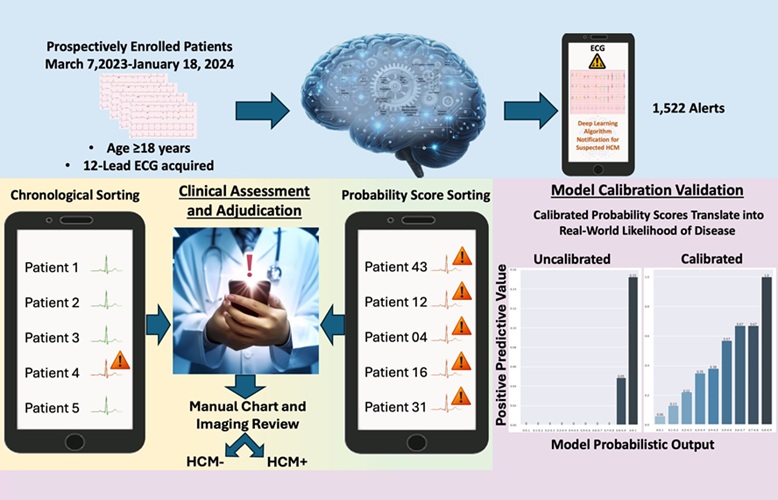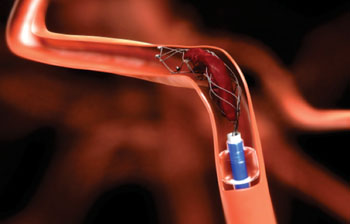Clot Removal Dramatically Improves Stroke Outcomes
|
By HospiMedica International staff writers Posted on 26 Apr 2015 |
Removing obstructing blood clots can significantly improve outcomes for people who suffer acute ischemic stroke, according to a new study.
Researchers at the UCLA Stroke Center (Los Angeles, CA, USA), University Hospital Essen (Germany), and 37 other institutions randomly assigned 196 eligible patients with stroke who were receiving or had received intravenous tissue plasminogen activator (t-PA) to continue with t-PA alone (control group, 98 patients) or to undergo endovascular thrombectomy with a stent retriever within six hours after symptom onset (intervention group, 96 patients). The primary outcome was the severity of global disability at 90 days on the modified Rankin scale.
The study, which was stopped early due to efficacy, showed that in the intervention group the rate of substantial reperfusion at the end of the procedure was 88%, compared to 25%–30% in the control group. Thrombectomy with the stent retriever plus intravenous t-PA also reduced disability at 90 days over the entire range of scores on the modified Rankin scale. Functional independence was higher in the intervention group (60%) than in the control group (35%). There were no significant differences in mortality or symptomatic intracranial hemorrhage. The study was published on April 17, 2015, in the New England Journal of Medicine (NEJM).
“We are very happy to see this decade-long research program result in an important advance for stroke patients. These findings are a paradigm shift — a new era in stroke care — and we are ecstatic,” said global lead author Prof. Jeffrey Saver, MD, director of the UCLA Stroke Center. “We will be able to treat many more patients, who will have much better outcomes. This is a once-in-a-generation advance in acute stroke care.”
“While this won’t help all stroke patients, the ones it will help have the most disabling strokes,” said study coauthor Sidney Starkman, MD, co-director of the UCLA Stroke Center. “Right now, they get t-PA and it helps a third of them, but the other two-thirds end up dependent on others for help or they die.”
For the study, the researchers used the Covidien (Dublin, Ireland) Solitaire FR revascularization device, a mechanical catheter-based thrombectomy system that combines the ability to restore blood flow, administer medical therapy, and retrieve clot in patients experiencing acute ischemic stroke.
Related Links:
UCLA Stroke Center
University Hospital Essen
Covidien
Researchers at the UCLA Stroke Center (Los Angeles, CA, USA), University Hospital Essen (Germany), and 37 other institutions randomly assigned 196 eligible patients with stroke who were receiving or had received intravenous tissue plasminogen activator (t-PA) to continue with t-PA alone (control group, 98 patients) or to undergo endovascular thrombectomy with a stent retriever within six hours after symptom onset (intervention group, 96 patients). The primary outcome was the severity of global disability at 90 days on the modified Rankin scale.
The study, which was stopped early due to efficacy, showed that in the intervention group the rate of substantial reperfusion at the end of the procedure was 88%, compared to 25%–30% in the control group. Thrombectomy with the stent retriever plus intravenous t-PA also reduced disability at 90 days over the entire range of scores on the modified Rankin scale. Functional independence was higher in the intervention group (60%) than in the control group (35%). There were no significant differences in mortality or symptomatic intracranial hemorrhage. The study was published on April 17, 2015, in the New England Journal of Medicine (NEJM).
“We are very happy to see this decade-long research program result in an important advance for stroke patients. These findings are a paradigm shift — a new era in stroke care — and we are ecstatic,” said global lead author Prof. Jeffrey Saver, MD, director of the UCLA Stroke Center. “We will be able to treat many more patients, who will have much better outcomes. This is a once-in-a-generation advance in acute stroke care.”
“While this won’t help all stroke patients, the ones it will help have the most disabling strokes,” said study coauthor Sidney Starkman, MD, co-director of the UCLA Stroke Center. “Right now, they get t-PA and it helps a third of them, but the other two-thirds end up dependent on others for help or they die.”
For the study, the researchers used the Covidien (Dublin, Ireland) Solitaire FR revascularization device, a mechanical catheter-based thrombectomy system that combines the ability to restore blood flow, administer medical therapy, and retrieve clot in patients experiencing acute ischemic stroke.
Related Links:
UCLA Stroke Center
University Hospital Essen
Covidien
Read the full article by registering today, it's FREE! 

Register now for FREE to HospiMedica.com and get access to news and events that shape the world of Hospital Medicine. 
- Free digital version edition of HospiMedica International sent by email on regular basis
- Free print version of HospiMedica International magazine (available only outside USA and Canada).
- Free and unlimited access to back issues of HospiMedica International in digital format
- Free HospiMedica International Newsletter sent every week containing the latest news
- Free breaking news sent via email
- Free access to Events Calendar
- Free access to LinkXpress new product services
- REGISTRATION IS FREE AND EASY!
Sign in: Registered website members
Sign in: Registered magazine subscribers
Latest Surgical Techniques News
- DNA Origami Improves Imaging of Dense Pancreatic Tissue for Cancer Detection and Treatment
- Pioneering Sutureless Coronary Bypass Technology to Eliminate Open-Chest Procedures
- Intravascular Imaging for Guiding Stent Implantation Ensures Safer Stenting Procedures
- World's First AI Surgical Guidance Platform Allows Surgeons to Measure Success in Real-Time
- AI-Generated Synthetic Scarred Hearts Aid Atrial Fibrillation Treatment
- New Class of Bioadhesives to Connect Human Tissues to Long-Term Medical Implants
- New Transcatheter Valve Found Safe and Effective for Treating Aortic Regurgitation
- Minimally Invasive Valve Repair Reduces Hospitalizations in Severe Tricuspid Regurgitation Patients
- Tiny Robotic Tools Powered by Magnetic Fields to Enable Minimally Invasive Brain Surgery
- Magnetic Tweezers Make Robotic Surgery Safer and More Precise
- AI-Powered Surgical Planning Tool Improves Pre-Op Planning
- Novel Sensing System Restores Missing Sense of Touch in Minimally Invasive Surgery
- Headset-Based AR Navigation System Improves EVD Placement
- Higher Electrode Density Improves Epilepsy Surgery by Pinpointing Where Seizures Begin
- Open-Source Tool Optimizes Placement of Visual Brain Implants
- Easy-To-Apply Gel Could Prevent Formation of Post-Surgical Abdominal Adhesions
Channels
Critical Care
view channel
Smart Bandage Monitors Chronic Wounds in Human Patients
A future smart bandage, envisioned as a "lab on skin," could assist both patients and caregivers by not only monitoring chronic wounds but also delivering treatment and accelerating the healing process... Read more
AI Identifies Patients with Increased Lung Cancer Risk Up To 4 Months Earlier
Earlier diagnosis plays a crucial role in improving the prognosis of cancer, as delays in starting therapy are associated with decreased survival rates. In most cases, cancer is first identified when symptoms... Read more
AI Algorithm Identifies High-Risk Heart Patients
Hypertrophic cardiomyopathy (HCM) is a complex condition characterized by the thickening of the heart muscle, which impairs the heart's ability to pump blood effectively. This forces the heart to work... Read more
Next Gen Hemodynamic Monitoring Solution Provides AI-Driven Clinical Decision Support
A new cutting-edge hemodynamic monitoring platform, equipped with predictive artificial intelligence (AI)-based algorithms, is designed to help clinicians proactively manage blood pressure fluctuations... Read morePatient Care
view channel
Portable Biosensor Platform to Reduce Hospital-Acquired Infections
Approximately 4 million patients in the European Union acquire healthcare-associated infections (HAIs) or nosocomial infections each year, with around 37,000 deaths directly resulting from these infections,... Read moreFirst-Of-Its-Kind Portable Germicidal Light Technology Disinfects High-Touch Clinical Surfaces in Seconds
Reducing healthcare-acquired infections (HAIs) remains a pressing issue within global healthcare systems. In the United States alone, 1.7 million patients contract HAIs annually, leading to approximately... Read more
Surgical Capacity Optimization Solution Helps Hospitals Boost OR Utilization
An innovative solution has the capability to transform surgical capacity utilization by targeting the root cause of surgical block time inefficiencies. Fujitsu Limited’s (Tokyo, Japan) Surgical Capacity... Read more
Game-Changing Innovation in Surgical Instrument Sterilization Significantly Improves OR Throughput
A groundbreaking innovation enables hospitals to significantly improve instrument processing time and throughput in operating rooms (ORs) and sterile processing departments. Turbett Surgical, Inc.... Read moreHealth IT
view channel
Printable Molecule-Selective Nanoparticles Enable Mass Production of Wearable Biosensors
The future of medicine is likely to focus on the personalization of healthcare—understanding exactly what an individual requires and delivering the appropriate combination of nutrients, metabolites, and... Read more
Smartwatches Could Detect Congestive Heart Failure
Diagnosing congestive heart failure (CHF) typically requires expensive and time-consuming imaging techniques like echocardiography, also known as cardiac ultrasound. Previously, detecting CHF by analyzing... Read moreBusiness
view channel
Expanded Collaboration to Transform OR Technology Through AI and Automation
The expansion of an existing collaboration between three leading companies aims to develop artificial intelligence (AI)-driven solutions for smart operating rooms with sophisticated monitoring and automation.... Read more

















